W&D CAMP ART AND EVENTS 2024
Art and events are the the backbone of our community at Whiskey & Dust, but this year is going to be a bit different. Whiskey & Dust will be a support camp for Mutant Vehicles but our "bar action" will take place as part of Golden Guy Alley.
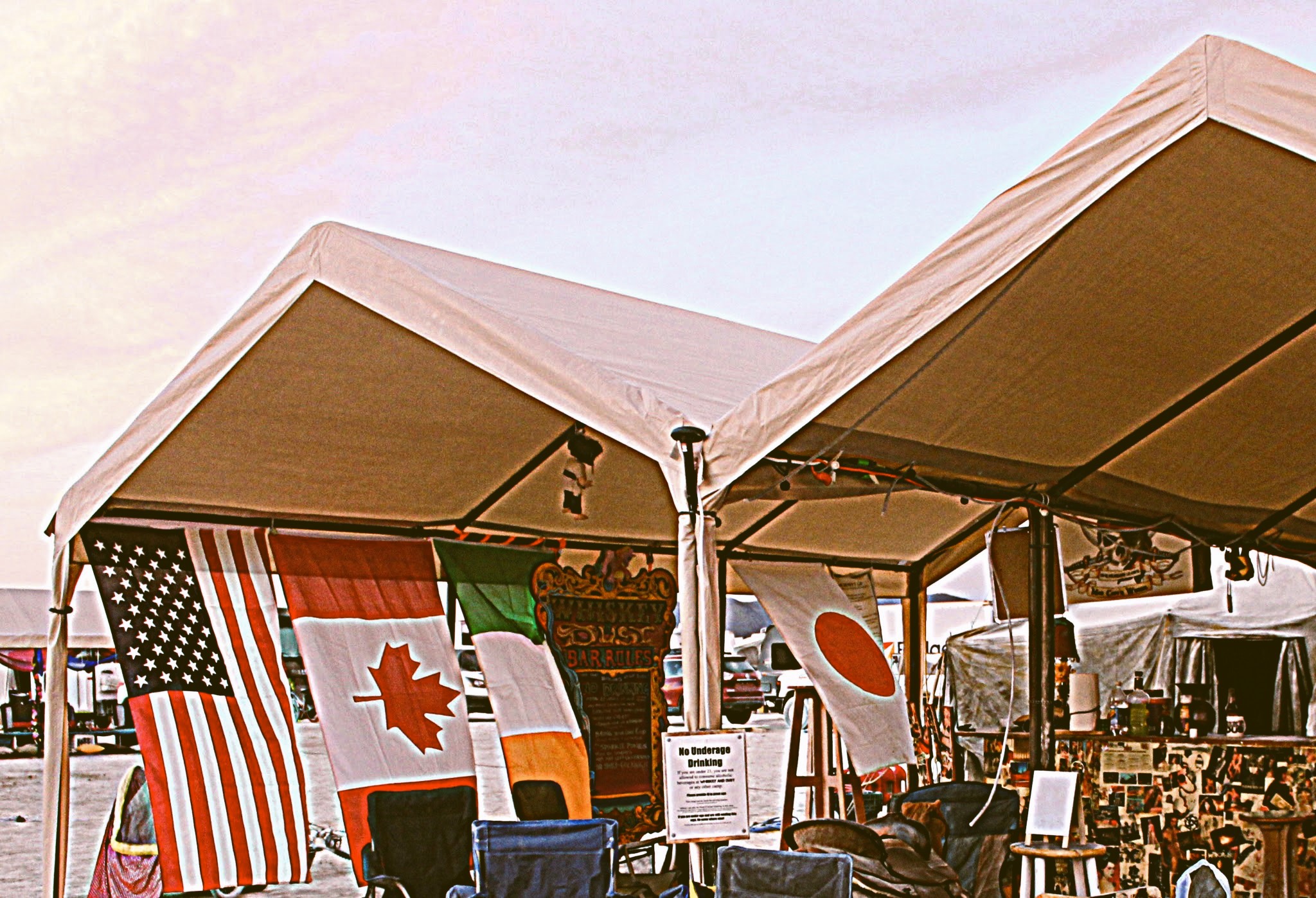
Whiskey Tastings and Bar Art
Okay, it is right there in the name! We are primarily a Whiskey Bar and we offer some of the finest whiskey on the playa! Unless you are a douche, then you get served Fireball or some shit like that. Come on by and hang at the bar or attend one of our Whiskey Tasting events. Just be prepared for shenanigans to ensue while you are here.
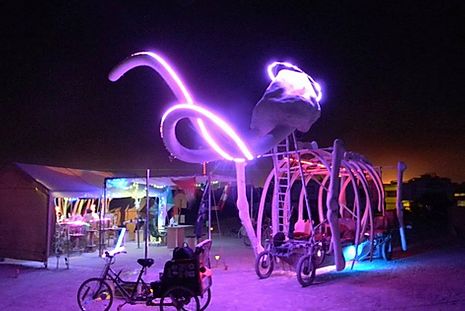
Ma'am: The Mammoth
Created by Nick DeWold, currently operated by Harvie Branscomb
"Ma'am: The Mammoth," a bicycle powered Mutant Vehicle built on an aluminum bicycle powered chassis for four bikes with skull, tusks and ribs made of laminated rigid insulation foam, was designed by Nick DeWolf and Harvie Branscomb, in Aspen, Colorado in the dawn of time. Nick was inspired by the Piltdown Man, the false missing-link hoax, and the Columbian mammoth skeleton found in the Black Rock Desert, which can be seen in the Paleontological Museum of Winnemucca.
This group collaboration was built and rebuilt by many friends of the Ma'am, including Eric Ringsby, who served as all purpose volunteer and financial contributor. Nick DeWolf passed away April 2006, and now Harvie Branscomb and Yayoi Wakabayashi carry on the Ma'am legacy.
WHERE
This art car can be seen at Whiskey and Dust Mutant Vehicle Support Camp in 2024, its chosen home base since 2015. Or find it wandering the desert during the event.
(Note: Jumping onto a moving vehicle can be dangerous. Please signal the driver to stop to board.)
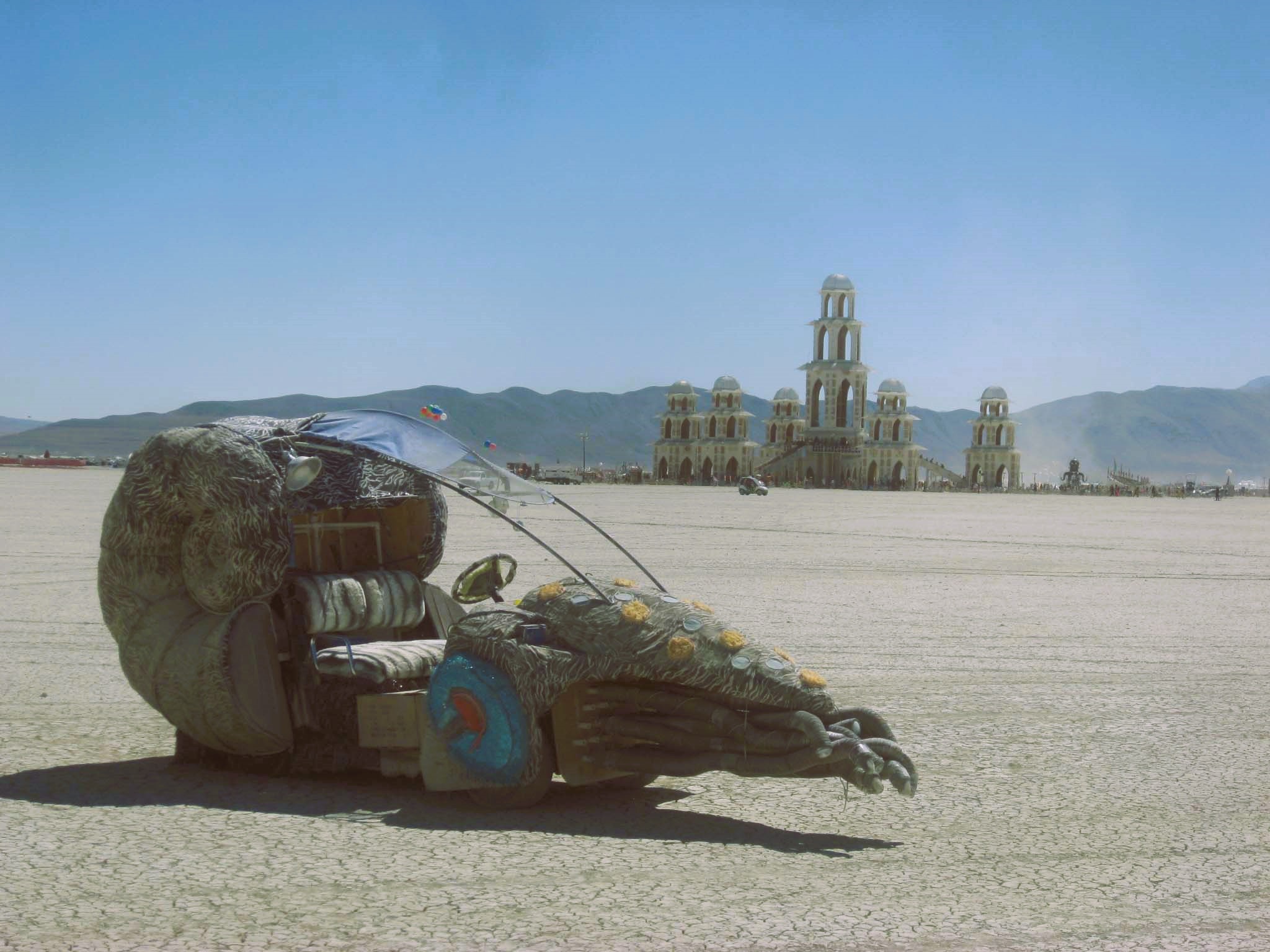
Fredrick the Nautilus
Created and operated by Tim Collins of Lakewood CO
Since 2006, "Frederick" the happy go lucky nautilus mutant vehicle has graced the playa with its charm and primarily serves trips to deep playa to explore the art there with new friends (i.e. strangers) picked up along the way. Giving rides to Burners he's never met before is one of the things Tim loves most about Burns! A wheelchair accessible vehicle, many riders might not have been able to experience deep playa otherwise due to mobility issues.
If you see the taxi style light on, hail Fredrick the Nautilus down to meet Tim and enjoy a ride you will recall fondly, long after the Burn is over.
WHERE
This art car can be seen at Whiskey and Dust Mutant Vehicle Support Camp in 2024. Or find it wandering the desert during the event.
(Note: Jumping onto a moving vehicle can be dangerous. Please signal the driver to stop to board.)
PAST W&D CAMP ART AND EVENTS
Whiskey & Dust has brought many awesome events and art projects to the playa since it began in 2009. Some are recurring, some are special one-time only gigs. Here are just a sampling of our past offerings. You will likely see new art and many recurring events return next year, but W&D events are taking 2024 off. See you on down the road!
Hey, but do come visit our playa famous W&D Bar in Golden Guy Alley in 2024 to drink some whiskey with us and get your Whiskey & Dust tramp stamp, um, we mean passport stamp!
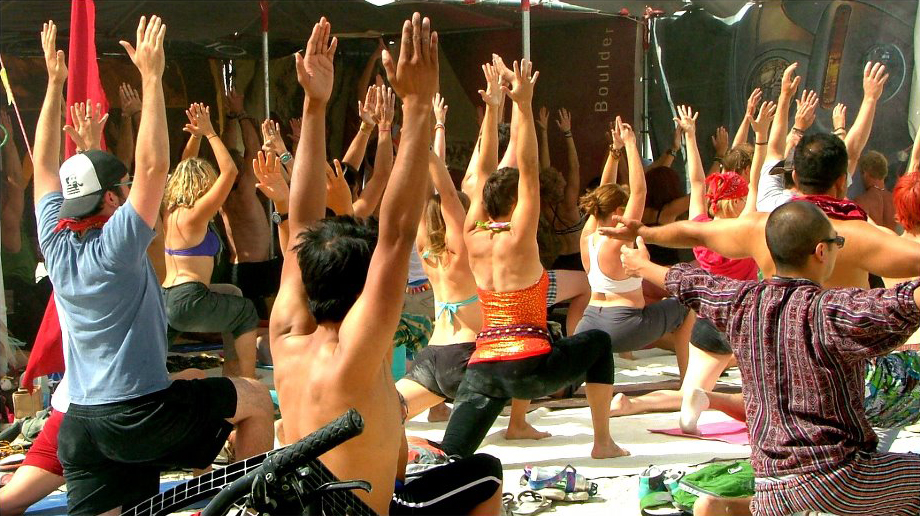
Morning Yoga
We are a whiskey camp with a little yoga problem. Daily morning yoga classes are designed to check movement, alignment, and intentions. All ability levels are welcome. Bring your own mat. Come for the yoga, stay for the whiskey!
Because Whiskey & Dust will operate its bar in Golden Alley in 2024, there will be no yoga for the first time since we began in 2009. Don't get down, dog, yoga will be returning in 2025.
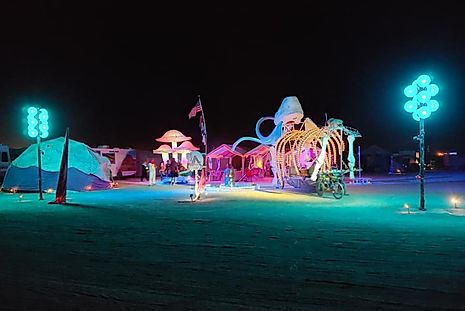
Bubble Street Lights
By Whiskey and Dust Members - 2018 through 2023
Ever wander down a dark street front? Well not at Whiskey and Dust. Our 4 whimsical street lights are 13 feet tall with 10 LED color changing globes. We invite you to act out your dream of being a clandestine spy, or a private eye on the case of a murder, or just let their lovely glow light your way as you journey our Black Rock Streets.
Resting at Whiskey and Dust home base in Denver for 2024; returning in 2025
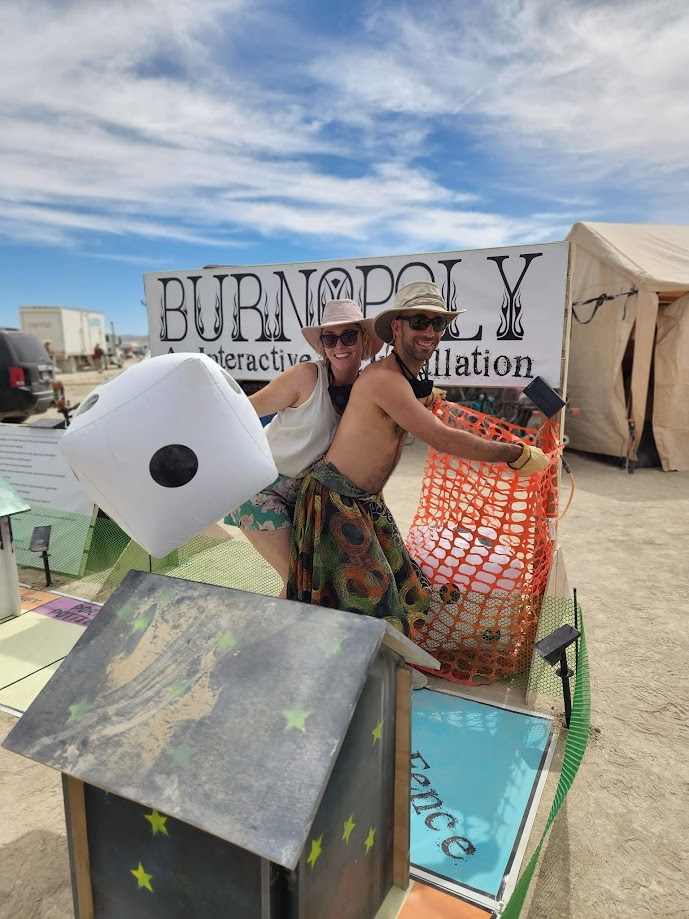
Burnopoly
By Whiskey and Dust Members - 2018 through 2023
An Interactive Art Installation, this W&D art installation features little Burnopoly houses decorated by our camp members, and inspired by our old "Donner Estates" Mini Houses which have been retired.
Come roll the giant dice and play Burnopoly! The squares are named for various Burning Man camps,
famed locations, and Burning Man's 10 Principles. Each square has a fun action to perform! Some will keep the game rolling and some will send you off on an adventure! Roll the dice to learn where Burnopoly will lead you.
Resting at Whiskey and Dust home base in Denver for 2024; returning in 2025
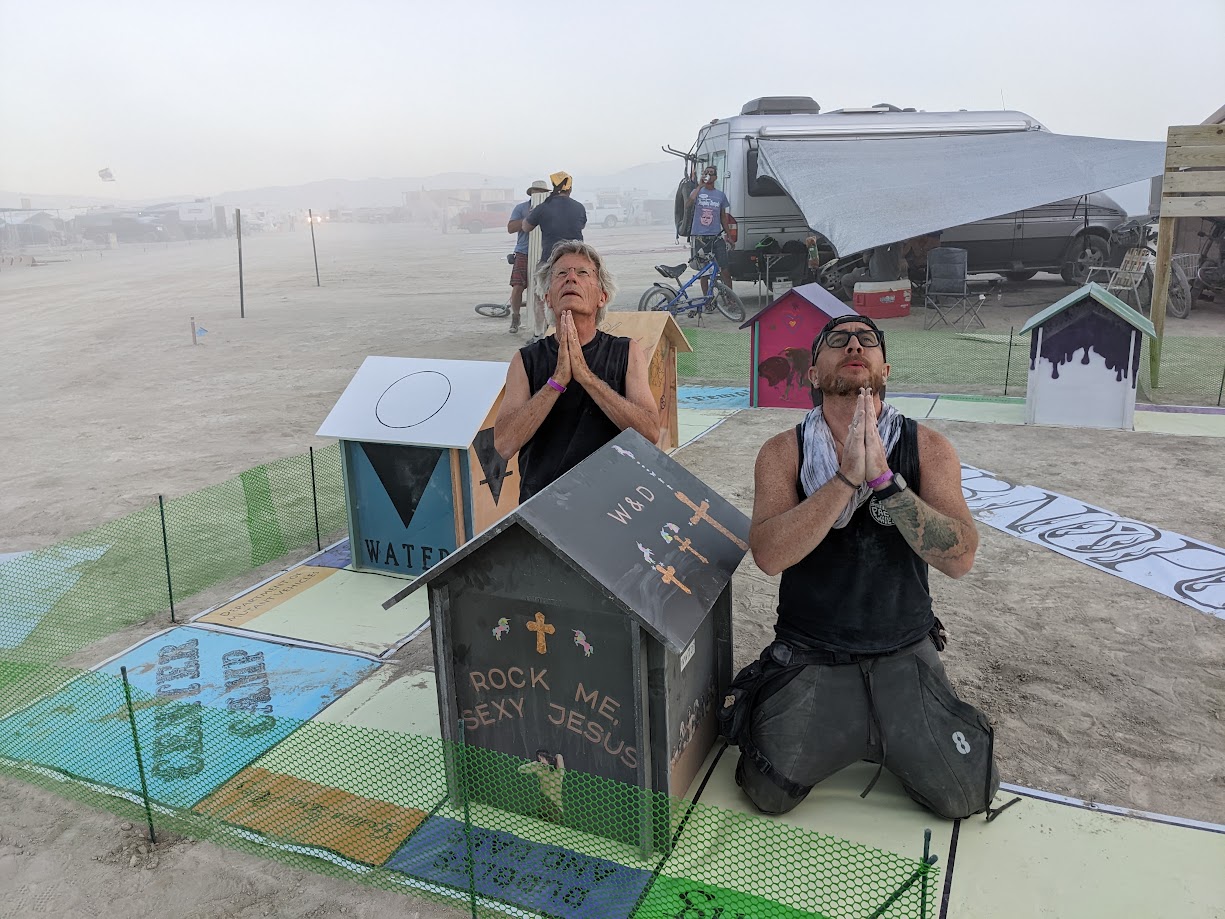
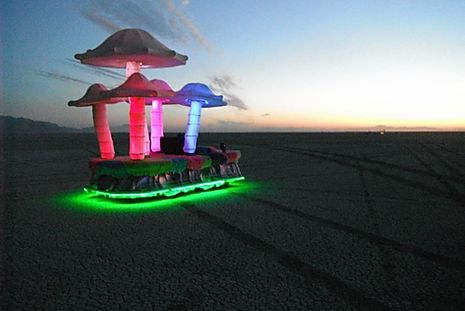
The Mushroom Patch
By Butch Kanter
This lovable, whimsical vehicle built by Butch Kanter, features 5 mushrooms (largest cap being 5 feet in diameter) on a converted Geo Metro base covered in soft fur. All the mushrooms sequence LED lights in various patterns to make it quite visible at night, as well as a LED strip at the base. Outfitted with speakers and a base, music can be heard streaming from this vehicle as it wanders around.
Additionally, regular updates to the vehicle both in 2016 and 2014 have enhanced the integrity of all aspects of the vehicle as the desert is a harsh environment.
Our beloved Mushroom Patch art car is taking a year off in 2024.
(Note: Jumping onto a moving vehicle can be dangerous. Please signal the driver to stop to board.)
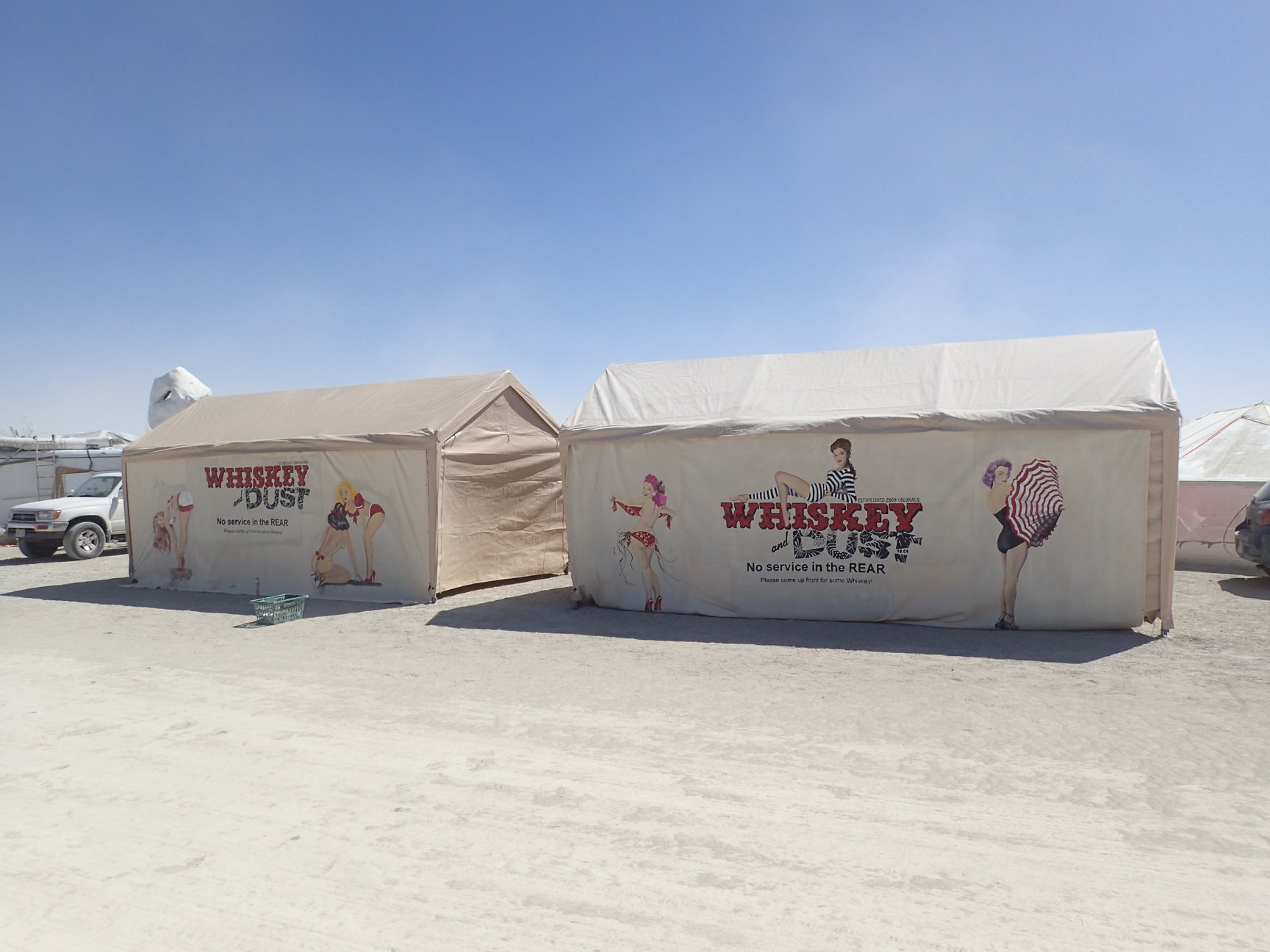
No Entry From Behind
Our unique camp layout in 2019 prompted the creation of this gorgeous (and functional) piece of camp art in keeping with the theme decor of our long-established bar, bar furniture, and our annual camp logos (created by camp artisit Marie Vlasic), which have appeared on stickers, temporary tattoos, condoms, and camp signage.

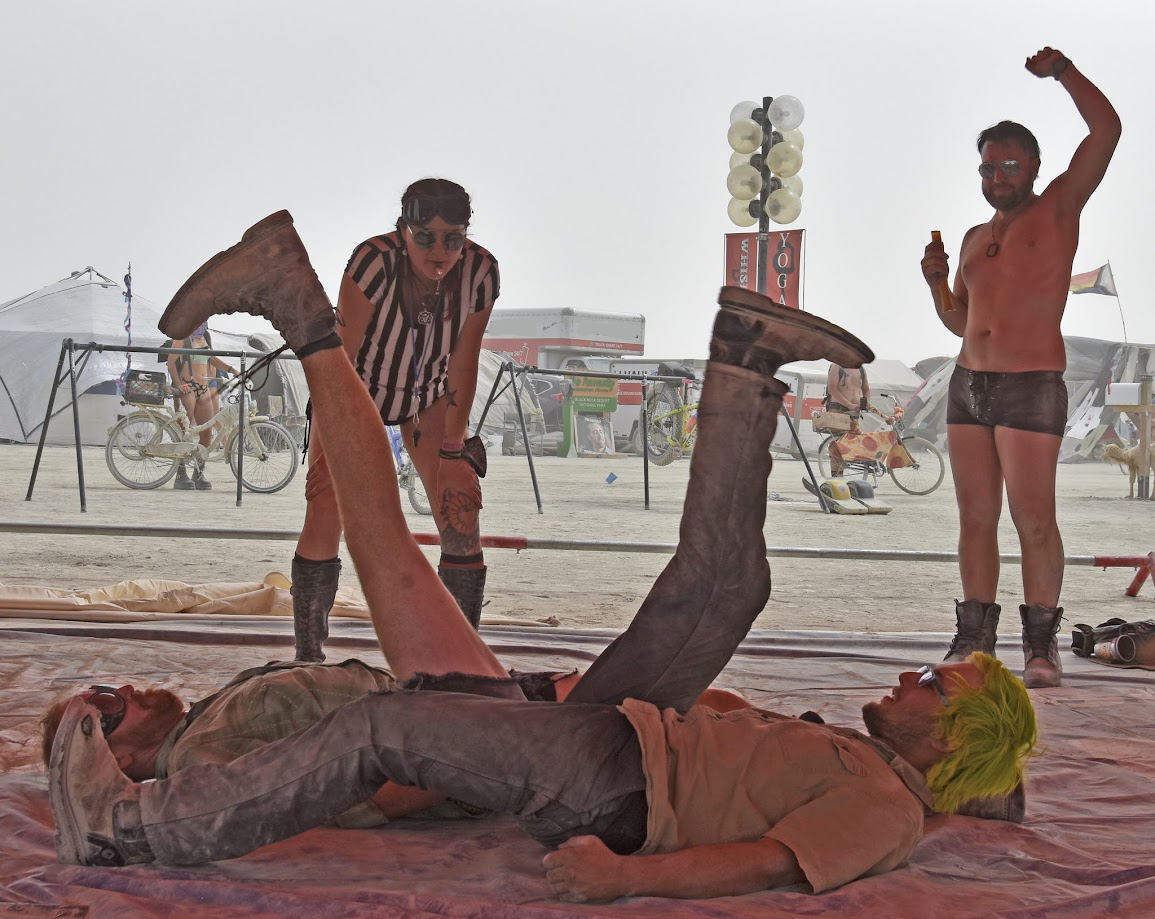
Leg Wrestling
This madness started in 2018 and has seen some major throw-downs and awarded the coveted belt to some truly incredible Leg Wrestling Champions! The event is an open invitational, inter-gender, adult (18+) competition. Come show us what you've got!
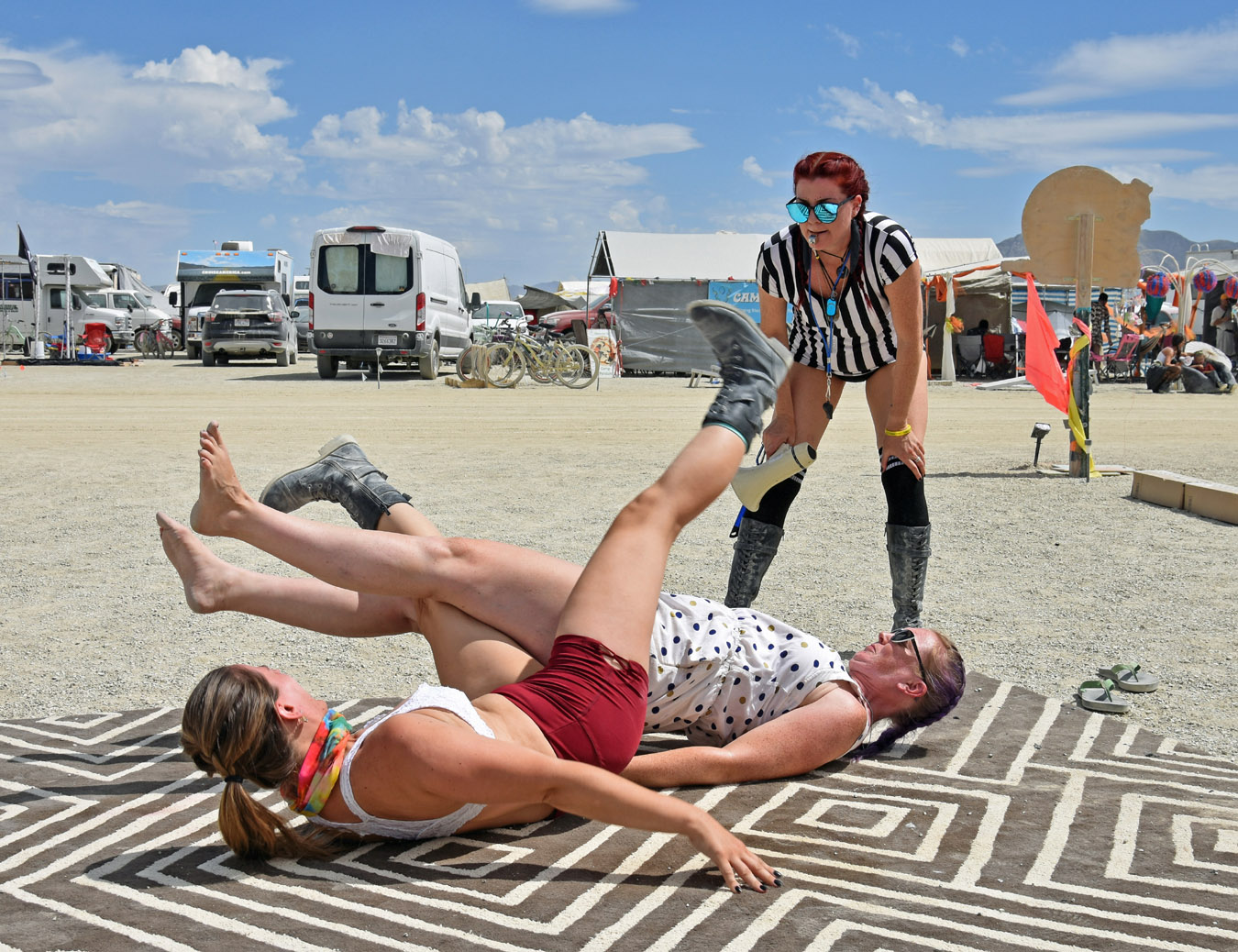
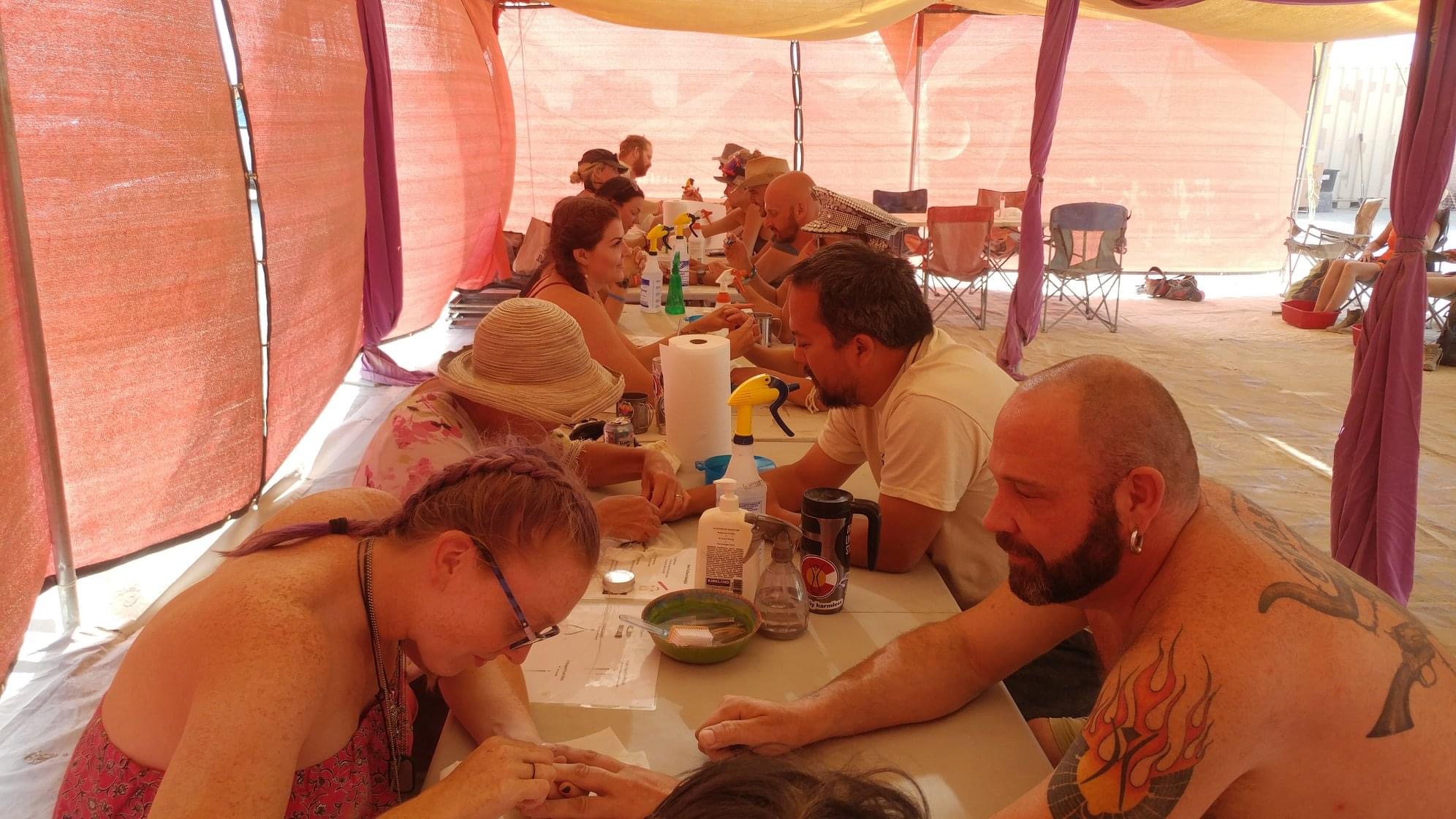
Hand Jobs
W&D has been gifting the playa community Hand Jobs since 2009!
Life on the playa is rough but that doesn’t mean your hands have to be! Come get a soothing hand massage with your choice of scented lotions and potions. Or, enhance your Playa-wear with a manicure and polish.
Show those you touch that you care – nothing says First Class better than soft, smooth hands.
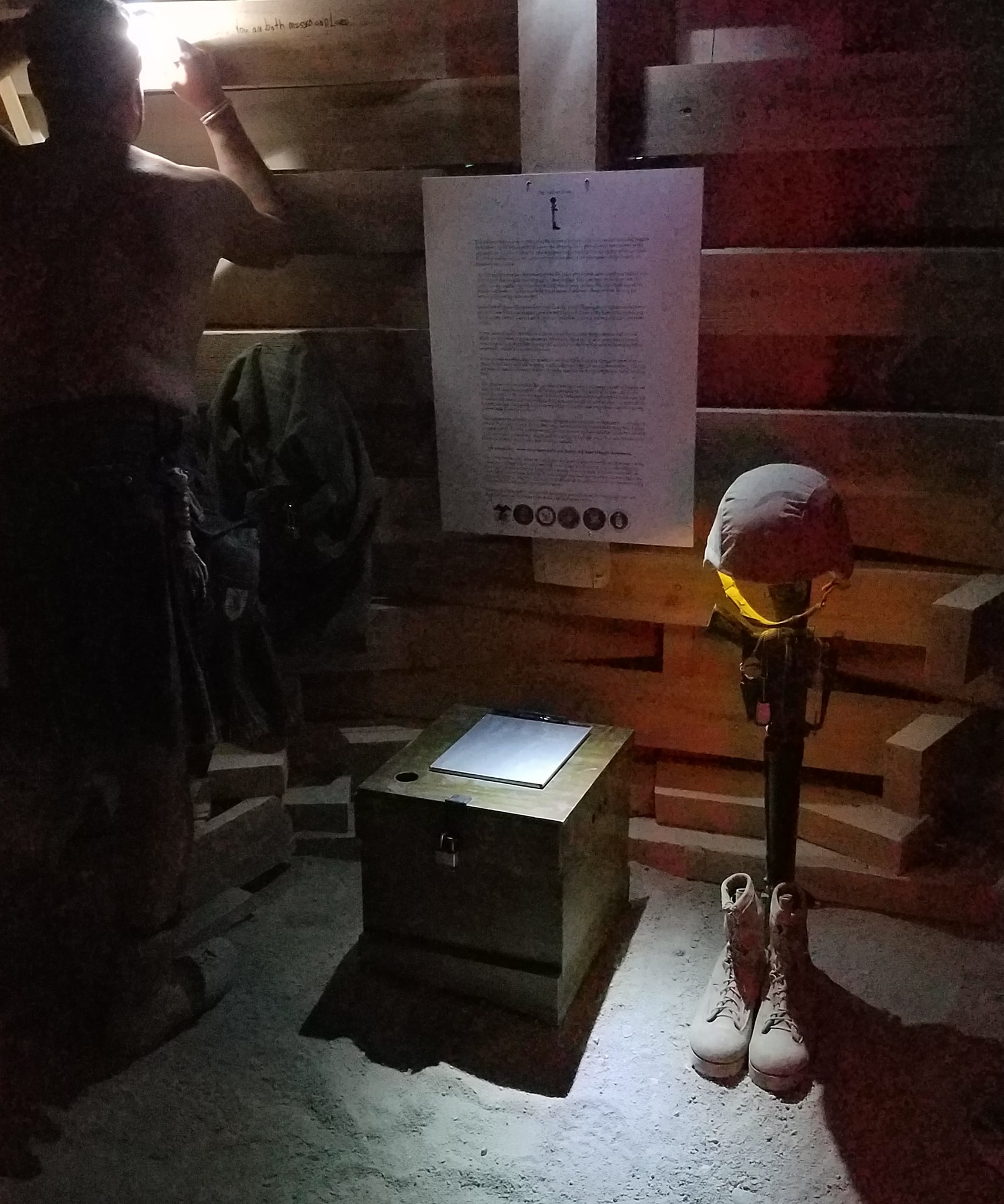
Soldier's Cross
By Jack Butler & Jerry Vanhoosen- 2017
The Soldiers/Battle cross, consisting of a rifle inverted between a pair of combat boots and topped by a helmet, is a powerful image to those who have served in the armed forces. It evolved from the practice of marking a burial place of a fallen combat soldier who could not be extricated because of remoteness of the location or requirements of battle. The rifle is topped with their helmet and possibly their dog tag for identification, in hope that the soldier’s body could be later recovered and buried with military honors.
Regardless of the conflict or country, the willingness of our military members to put their lives at risk and in some cases pay the final price is one of the highest honorable acts in our society. Soldiers do not get to choose to go to war, they are ordered and carry out those orders. Whether in times of war or in peace, those who volunteer often sacrifice youth, relationships, physical and mental health to serve. Those most affected deal with the terrors and rigors of combat and when required apply the oath between soldiers of never leaving a comrade on the battlefield, a code as old as conflict itself.
The weight of that promise can be very heavy. Scars and emotions suppressed and carried can shape and profoundly effect a person’s life. The inability to save a life or the necessity to take a life will each leave their mark. The myriad energy of the acts committed or seen as a solider is a burden borne by too many. Suppression of the pain in order to continue is part of the soldier's burden.
This project, placed in the Temple in 2017, was not intended or designed with the intent to celebrate war, or the violence or the loss that results from it. The project was placed included in the Temple in hopes that suffering would be lessened, that the release of the energy of pain could occur in this safe place. and to allow others to to leave a memory of comrades fallen and their own traumas endured. You promised to never leave them and never forget. You have brought them home. Participants were invited to write something and place it in the box provided - whether it is the name of a lost comrade, an event that profoundly affected you, or anything you have been carrying which you would like to release. Remembrances of friends and family as well as gratitude to those members of your society who have sacrificed for what we all enjoy were invited to be left as well. All notes left were burned with the temple and with them, the energy and pain hopefully lessened the giver's burden, and allowed healing to begin.
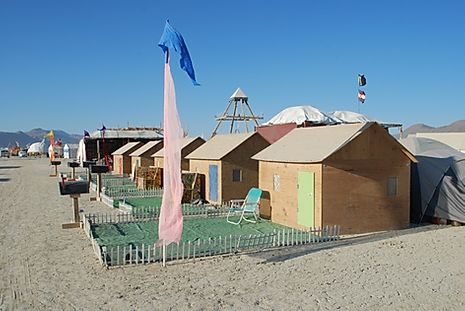
Donner Trail Estates
BRC's first and only suburban subdivision where we can once again live the American dream of gentrified minimalistic housing debuted at W&D in 2009. Amenities included street side location to watch all the fun, lawn service, picket fence installment, solar lights, personal mailboxes, activities and bar service at the main office. Sorry, no hot tubs!
(Note: Houses occupied by camp members during the event. Please knock and ask to see inside.)
Whiskey and Dust retired the Donner Train Estates in 2017 to make place for new art and interaction.
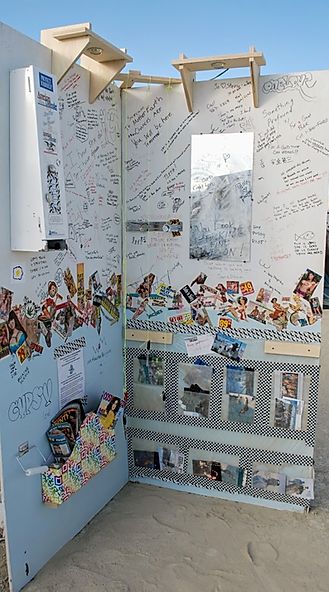
The Bathroom Wall
By Kent Ward and Tonda Phalen- 2012
This in-camp art piece in 2012 was imagined by Kent and Tonda and created at the 2012 Burn. It was designed to be interactive on many levels with visitors to the Whiskey and Dust camp.
The Bathroom Wall included a condom dispenser with gratis custom W&D condoms, as well as a take or leave adult magazine library.
Additional gifts available to visitors of the Bathroom Wall were W&D postcards created by Tonda using images she previously photographed at Burning Man, and also W&D temporary tattoos from a design created by camp artist Marie Vlasic.
Visitors were encouraged to participate with the art by leaving graffiti on the walls, and were given some special love with an inspirational mirror that provided positive affirmations and lit up at night to throw visitors into a special glow.
The art piece was ultimately burned. The popular W&D postcards made a return in 2016, with new images created by Tonda, and were distributed that year directly from the W&D bar. To view postcards, click here.
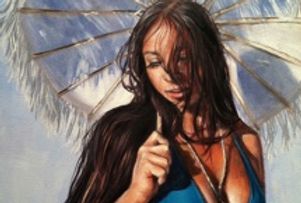
Black Rock Portrait Project
By Marie Vlasic - 2011
"The Black Rock Portrait Project" is an ongoing series of oil paintings biased on photographs taken by the artist (and with assistance from other photographers in 2011) at the Burning Man festival. These paintings have also been published as a print collection. For more information on the project and the subsequent book, please visit: The Black Rock Portrait Project at https://vlasicstudio.com/blackrock-portraitproject
